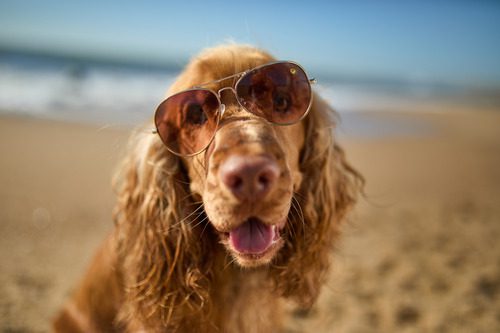Can Dogs Get Sunburn?
Some dogs love soaking up the sunshine just as much as their humans do. Whether they’re lounging on the patio, running around the dog park, or spending the day at the beach, they’re just as susceptible to the sun’s effects. But can dogs get sunburn? The short answer is yes. Just like people, dogs can experience sunburn, especially on areas with thin fur or exposed skin. In this blog, we’ll explore how dogs can get sunburn, which dogs are most vulnerable, the signs of sunburn, how it can affect your pet’s health, and what you can do to help prevent it. If you’re in Silver Spring, MD and require emergency care or a specialty consultation, contact Apex Vets today.

How Can Dogs Get Sunburn?
Dogs can get sunburn the same way humans do: through prolonged exposure to ultraviolet (UV) rays. While their coats offer some natural protection, it’s not always enough, especially for certain breeds or body areas. The sun’s rays can penetrate fur and burn the skin underneath, leading to discomfort, redness, and more serious skin conditions.
Sunburn in dogs usually occurs during peak sun hours, between 10 a.m. and 4 p.m., when UV rays are most intense. Just a few hours outside without proper protection can result in a burn, particularly if your dog has light-colored or sparse fur. It’s a common misconception that only hairless dogs or those with white coats are at risk. In truth, dogs can get sunburn regardless of breed or coat color. The risk simply varies based on skin exposure, fur density, and sun intensity.
Which Dogs Are Most at Risk?
While any dog can experience sunburn, some are more vulnerable than others. Several factors increase the likelihood of a dog getting sunburned, and knowing these can help pet parents take preventive steps.
Dogs with Light or Thin Coats
Breeds with lighter-colored or thinner fur such as Dalmatians, Boxers, Pit Bulls, and Greyhounds have less natural protection against UV rays. White or pale-colored fur does not block the sun effectively, which means the skin underneath is more likely to burn.
Hairless or Short-Haired Breeds
Chinese Cresteds, American Hairless Terriers, and other hairless breeds have little to no fur to serve as a barrier. Their exposed skin makes them highly susceptible to sunburn with even minimal exposure.
Dogs with Shaved or Clipped Fur
If your dog recently had a summer haircut or a surgical procedure that required shaving, those exposed areas are now unprotected. The skin underneath hasn’t built up any tolerance to sun exposure, making it a prime target for burns. Additionally, areas like the nose, ears, belly, and groin are naturally more exposed and vulnerable, regardless of breed or coat length.
Common Signs Your Dog Has a Sunburn
Recognizing the signs of sunburn can help you intervene early and prevent the issue from worsening. Sunburn symptoms in dogs can vary, but they often include:
- Red or pink skin, especially on the nose, ears, or belly
- Flaky, dry, or crusty skin
- Tenderness when touched
- Whimpering or signs of discomfort when lying down
- Excessive licking or scratching of affected areas
- Hair loss in sun-exposed patches
- Blisters or sores in severe cases
These symptoms typically appear a few hours after sun exposure and may worsen over the next day. If you suspect your dog has sunburn, avoid further sun exposure and speak with your veterinarian about next steps.
How Sunburn Can Impact Your Dog’s Health
Mild sunburn may heal within a few days, but repeated or severe sunburn can lead to more serious problems. Ongoing UV exposure increases the risk of skin damage and long-term complications.
Skin Damage and Infections
Damaged skin can become dry, cracked, and irritated, creating an opportunity for bacteria to enter and cause infection. If the skin is blistered or raw, it may also attract excessive licking, which can delay healing or lead to hotspots.
Long-Term Risks
One of the most concerning effects of repeated sunburn in dogs is an increased risk of skin cancer. Just like in humans, dogs can get sunburn that damages skin cells over time. Skin cancers such as squamous cell carcinoma, malignant melanoma, and hemangiomas have been linked to chronic sun exposure in dogs.
Certain breeds, especially those with short hair, light pigmentation, or hairless traits, are already predisposed to skin cancer, so limiting sun exposure is essential for long-term wellness.
Ways to Help Protect Your Dog from Sunburn
While you can’t completely avoid the sun, there are several ways to reduce your dog’s risk of sunburn and UV damage. Prevention is key, especially during Maryland’s warmer months when sunlight is strongest.
Use Pet-Safe Sunscreen
Pet-safe sunscreen is designed for a dog’s sensitive skin and avoids harmful ingredients like zinc oxide or para-aminobenzoic acid (PABA), which can be toxic if ingested. Apply sunscreen to exposed areas such as the nose, ears, belly, and any shaved or light-furred spots. Reapply throughout the day, especially after swimming or playing in water.
Limit Midday Outdoor Time
Try to schedule walks and outdoor play during the early morning or later in the evening when the sun is less intense. If your dog must be outside during peak sun hours, make sure they have access to shade and cool surfaces.
Provide Protective Clothing
UV-blocking shirts, lightweight bodysuits, and wide-brimmed hats made specifically for dogs can shield sensitive skin while still allowing your pet to enjoy the outdoors.
Watch for Warning Signs
Even with precautions, dogs can get sunburn. Keep an eye on their skin after long days outside, especially if they’ve been swimming or lounging in full sun. If you notice any redness, discomfort, or changes in behavior, follow up with your veterinarian.
Protect Your Dog Year-Round
The idea that only humans need sun protection is a common misunderstanding. The truth is, dogs can get sunburn, and it can lead to discomfort, pain, and even serious health issues. Whether you’re heading to the dog park, spending a day by the water, or just enjoying your backyard, sun safety matters for pets too. Take proactive steps to protect your dog from the sun’s harmful effects, especially if they have thin fur, pale skin, or a history of skin issues. Keep outdoor time safe, shade-filled, and monitored.
If you’re in Silver Spring, MD and require emergency care or a specialty consultation, contact Apex Vets today. Our team is here to help your pet feel their best, rain or shine.
